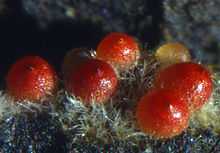Nectria
This article is about a genus of fungi. For the echinoderm genus, see Nectria (sea star).
| Nectria | |
|---|---|
 | |
| Perithecia of an unidentified Nectria species | |
| Scientific classification | |
| Kingdom: | Fungi |
| Division: | Ascomycota |
| Class: | Sordariomycetes |
| Order: | Hypocreales |
| Family: | Nectriaceae |
| Genus: | Nectria (Fr.) Fr. (1849) |
| Type species | |
| Nectria cinnabarina (Tode) Fr. (1849) | |
| Synonyms[1] | |
|
Ephedrosphaera Dumort. (1822) | |
Nectria is a genus of Ascomycete fungi. They are most often encountered as saprophytes on decaying wood but some species can also occur as parasites of trees, especially fruit trees (for example apple) and a number of other hardwood trees. Some species are significant pests causing diseases such as apple canker, Nectria twig blight, and coral spot in orchards.
It is ubiquitous in cool temperate Europe and North America and appears to be an introduced species in New Zealand and Australia. The occurrence in New Zealand was first identified in 1996 in Otago and Southland although it is believed to have been present since the 1980s. In North America, Nectria infections have had economically important impacts on forestry and forest products including aspen, red oak, maple, beech, poplar, and birch. Species of Nectria also occur in warmer climates including island groups such as Hawaii. According to the Dictionary of the Fungi (10th edition, 2008), the genus contains 82 species.[2]
Species
- Nectria cinnabarina
- Nectria coccinea
- Nectria ditissima
- Nectria diversispora
- Nectria eustromatica
- Nectria foliicola
- Nectria fragilis
- Nectria fuckeliana
- Nectria galligena
- Nectria haematococca
- Nectria episphaeria
- Nectria magnoliae
- Nectria mammoidea var. rubi
- Nectria mauritiicola
- Nectria peziza
- Nectria pseudotrichia
- Nectria punicea
- Nectria radicicola
- Nectria ramulariae
References
- ↑ "Nectria (Fr.) Fr. 1849". Index Fungorum. International Mycological Association. Retrieved 2011-02-03.
- ↑ Kirk PM, Cannon PF, Minter DW, Stalpers JA. (2008). Dictionary of the Fungi (10th ed.). Wallingford, UK: CABI. p. 461. ISBN 978-0-85199-826-8.